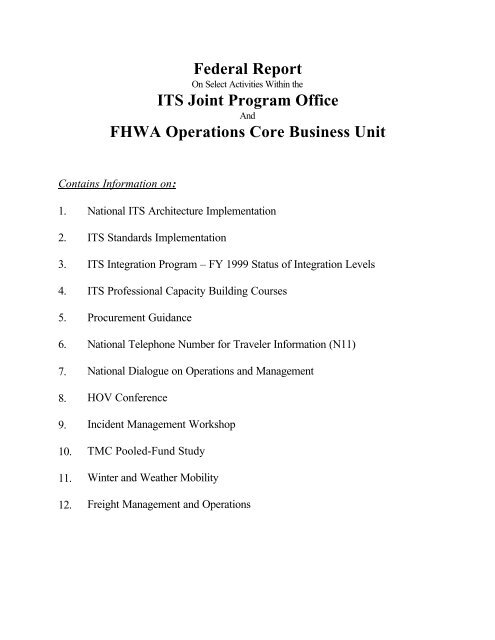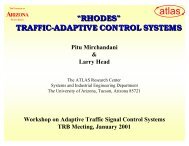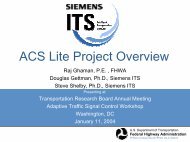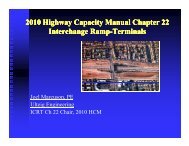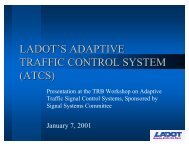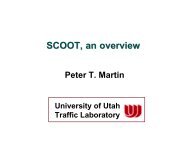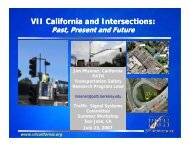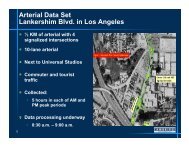handout - Traffic Signal Systems Committee
handout - Traffic Signal Systems Committee
handout - Traffic Signal Systems Committee
Create successful ePaper yourself
Turn your PDF publications into a flip-book with our unique Google optimized e-Paper software.
Federal ReportOn Select Activities Within theITS Joint Program OfficeAndFHWA Operations Core Business UnitContains Information on:1. National ITS Architecture Implementation2. ITS Standards Implementation3. ITS Integration Program – FY 1999 Status of Integration Levels4. ITS Professional Capacity Building Courses5. Procurement Guidance6. National Telephone Number for Traveler Information (N11)7. National Dialogue on Operations and Management8. HOV Conference9. Incident Management Workshop10. TMC Pooled-Fund Study11. Winter and Weather Mobility12. Freight Management and Operations
1. National ITS Architecture and Standards ImplementationLegislative Provision in TEA-21:“The Secretary shall ensure that intelligent transportation system projects carried out using fundsmade available from the Highway Trust Fund, . . . conform to the national architecture,applicable standards or provisional standards, and protocols developed under subsection (a).”-TEA-21 Title V, Sec. 5206(e)U.S. DOT Approach:Interim Guidance• First step towards incremental implementation of TEA-21 conformity requirement –issued October 1998Final Policy• Developed through formal rule-makingMajor Policy Objectives:Implement TEA-21• Support key Federal priorities:• Integration• Interoperability• Use of the National ITS Architecture and applicable standards• Incorporate ITS into existing transportation planning and project designproceduresFederal Register Publication:Notices of Proposed Rulemaking• Metropolitan and statewide planning (FHWA and FTA), (includes ITS architecture andstandards)• Intelligent Transportation System Architecture and Standards (FHWA)• Request for comment on proposed changes in FTA circulars (FTA)• Will replace Interim Guidance (issued in October 1998) if adopted as a final rule• Publication expected in Feb/March 2000• 90-day comment period• Six outreach sessions around the country(during comment period)
Architecture Training & Workshops:• 2 & 3-day architecture training courses – still being offered for free• Advanced architecture training – open to Federal staff now; opening to stakeholders inthe spring• Tier I and Tier II workshops - available to Metro areas through Service Plan program;provides a head start on developing a regional architectureITS Project Eligibility• Broad definition based on ITS User Services• Emphasizes need to develop Regional ITS Architectures• uncover nontraditional ITS projects, e.g., police vehicles equipped withcommunications for improved coordinated incident response• Besides ITS Architecture and Standards, may apply to Design-Build provision [TEA-21, section 1307(a)(3)]Operating Costs for TMS• TEA-21 clarified & reiterated flexibility of Title 23 (Federal-aid) funding for operations• NHS, STP, CMAQ explicitly allow operating costs• Broad definition of operating costs that includes certain system maintenance activities• e.g., efforts to assure system performance, replacement of damaged traffic controlequipment2. ITS Standards ImplementationStandards Development Status (as of 22 December 1999):• 30 Approved by Standards Development Organizations• 32 in ballot• 18 under developmentDSRC Rulemaking:Testing:The notice of proposed rule-making was published in the December 30, 1999 edition of theFederal Register. The notice applies to CVO applications.Formal standards testing and complete documentation of test results for the use of the ITS
community is being carried out by FHWA using the Battelle Memorial Institute as the supportcontractor. At least 10 standards are expected to go through formal testing this year. Theseapply to NTCIP Dynamic message signs, actuated signal controllers, center to centercommunications, and CVO safety and credentialing. The first formal test is expected to takeplace in February 2000.Case Studies involving testingAn experience-based case study of a dynamic message sign implementation by the VirginiaDepartment of Transportation (VDOT) was carried out by AASHTO, ITE and NEMA.Formal testing described in the case study includes factory demonstration and acceptance tests,software tests, system acceptance tests, an operational test period, and specific NTCIP testing.The testing procedures provide step-by-step instructions using the NTCIP Exerciser, which is asoftware program that simulates NTCIP communications and devices. The specificationsrequired use of the NTCIP Exerciser to test NTCIP-compliance.A case study of a dynamic message sign implementation by the Washington StateDepartment of Transportation (WSDOT) was also carried out by AASHTO, ITE and NEMA.The testing procedures were developed as a cooperative effort between the sign vendor andWSDOT. The vendor developed a field device simulator compatible with the central system.The signs were tested using the NTCIP Exerciser and the NTCIP Field Device Simulator.Final acceptance was based on the functionality of the signs within the central system.A third NTCIP case study on actuated signal controller object definition involved a City ofPhoenix project that included the replacement of the central traffic control system and theupgrade and purchase of additional traffic signal controllers. The NTCIP was thecommunications protocol for both. During testing the vendor defined a set of objects anddeveloped the testing software code. Integration testing followed testing of the individualcomponents. The vendor and the system integrator developed the testing procedurescollaboratively and worked together to develop an acceptable integrated system.Standards DeploymentsThe following ITS Standards are already being used at various levels by deployment sites. Insome cases, these deployments involve using draft standards. As the equipment is deployedand used in day to day operations, experienced based test results will become available.NTCIP Dynamic Message Signs (DMS)• Santa Monica, CA• Lakewood, CO• ISHTA (Chicago, IL)• Minneapolis/St. Paul, MN• Rochester, NY• Long Island, NY
• Virginia• Washington• Houston, TXNTCIP Actuated <strong>Signal</strong> Controller Units (ASC)• Mesa, AZ• Phoenix, AZ• Lakewood, CO• Miami, FL• Orlando, FL• Peoria, IL• Indianapolis, IN• High Point, NC• Lima, OH• UtahNTCIP Center to Center• Minneapolis/St Paul, MN• Dallas/Fort Worth, TX• San Gabriel Valley, CANTCIP Class ”B” Protocol• Highpoint, NCNTCIP Real Time Weather Information <strong>Systems</strong>• MinnesotaITE <strong>Traffic</strong> Management Data Dictionary• Dallas/Fort Worth, TXTCIP – On Board Objects (Partial, Vehicle Area Network)• Houston, TX<strong>Traffic</strong> Management Data Dictionary (TMDD) - ITEWork has been completed on Sections 1-4 covering traffic data, incidents, construction, trafficcontrol and external devices such as CCTV, DMS and HAR. These sections contain new dataelements which were developed in close coordination with other related standards developmentactivities such as NTCIP, TCIP, and IEEE and SAE standards. Sections 1-4 have been sentto the approval boards of ITE and AASHTO for final approval.Work on the Message Sets for External <strong>Traffic</strong> Management Center Communications(MS/ETMCC) has also been completed. This work has been coordinated with the IEEE
Incident Management Message Sets development. Work is now underway on an Event ReportMessage (ERM) for reporting highway events to Information Service Providers (ISPs) and toother agencies not closely involved in managing the event. The new data elements which werecreated for the ERM have either been incorporated in Sections 1-4 where appropriate or willbe placed in a new Section 5. The ERM work will also necessitate an amendment to theMS/ETMCC.Information on the TMDD is available on the ITE web site at www.ite.org under AStandards@on the index.Incident Management Message Sets - IEEEThe development of the P1512 Base Standard ACommon Incident Management Message Setsfor Use By Emergency Management Centers@ has been completed. The standard wassuccessfully balloted in November 1999. Comments received in the ballot process are nowbeing resolved. It is anticipated that this standard will receive final approval by IEEE inFebruary 2000.The Incident Management Working Group (IMWG) which developed the standard is nowreviewing the project plan for Phase II of this standards effort. Phase II will include thefollowing standards in the P1512 family:• P1512.1 - <strong>Traffic</strong> Incident Management Message Sets for Use by EmergencyManagement Centers• P1512.2 - Public Safety Incident Management Message Sets for Use by EmergencyManagement Centers• P1512.3 - Hazardous Material Incident Management Message Sets for Use byEmergency Management Centers• P1512.a - Emergency Management Data DictionaryThe Phase II work should start early in 2000 and be completed by mid to late 2001.Information on the P1512 standards development effort is available on the IMWG home pageat http://grouper.ieee.org/groups/scc32/imwg/index.html. Information on all of the ITSstandards development and testing work can be found on the U.S. DOT ITS web site atwww.its.dot.gov/standard/standard.htm.3. ITS Integration Program – FY 1999 Status of Integration LevelsOf the 64 FY 1999 earmark projects, all 64 projects will result in ITS integration at thefollowing levels:
Heavy activity (11-17 projects) is planned to integrate:• Arterial management among neighboring jurisdictions• Between Arterial and Freeway management• Between Incident Management and Arterial and Freeway ManagementModerate activity (6-9 projects) is planned to integrate:• Incident and Freeway Management with Traveler Info <strong>Systems</strong>• Emergency Management with arterial and incident management• Transit management across neighboring transit agencies and transit management withFreeway and Arterial managementLight activity (1 to 4 projects) is planned to integrate:• Arterial and Transit Management with Traveler Info <strong>Systems</strong>• Electronic Toll Collection with arterial and freeway management or other neighboringtoll agencies• Arterial systems with Highway-Rail intersectionsNo projects plan to integrate:• Electronic Fare payment among neighboring transit agencies or between transit andelectronic toll agencies• Highway-Rail intersections and incident management4. Professional Capacity Building CoursesThe ITS PCB Web Page is Now Available:www.its.dot.gov or www.pcb.volpe.dot.govThe ITS PCB Program was formed to assist transportation professionals in developing theknowledge, skills, and abilities required to deploy, operate and manage ITS projects. TheProgram is comprehensive and multi-modal in nature, addressing the needs of professionals atall levels of government and within academia, professional associations, and public and privatesector transportation agencies.This web site provides a comprehensive description of ITS PCB Program offering available totransportation professionals. It also includes links to other relevant web sites and names ofindividuals who can assist in further building ITS professional capacity. Four PCB elements areincorporated:Training
This section includes all the ITS PCB courses and seminars available at your fingertips. Searchthrough the database of the ITS PCB Program, National Highway Institute, National TransitInstitute, the Motor Carrier Safety Administration, and ITS America for training in critical ITSsubjects. This function provides course objectives, contact names and schedule information.Course slides and instructor notes are available for download on selected courses. Thesecourses can then be tailored to meet the needs of your local audience.EducationColleges and universities offer undergraduate, graduate, and extension programs to preparecurrent and future transportation professionals to deploy ITS projects. The ITS Education andTraining catalog for U.S. Universities documents courses offered at higher educationinstitutions.Technical AssistanceHands-on technical assistance helps professionals in solving transportation problems as theyarise. For example the Peer-to-Peer Program provides at desk-reviews, telephone anddocumentation support, and site visits. ITS Specialists located at FHWA Resource Centersand FTA Regional Offices are also listed.Information Outreach and DisseminationInformation about ITS events, projects, studies, and other publications is supplied by numerousorganizations. The National Associations Working Group for ITS electronically distributes thenewsletter of the ITS Cooperative Deployment Network monthly. ITS America also offers anelectronic newsletter. The ITS Joint Program Office sponsors the Electronic Document Librarywhere one can access ITS studies, lessons learned, and guidelines documents. A series of sixPCB reports are available to download to your desktop computer or to view online. Thesereports discuss the training and education needs of transportation professionals, including astrategy to meet those needs both now and in the future.Other Links to Related SitesThe related links for PCB training opportunities and additional educational and trainingresources are provided for universities and professional associations such as ITE and ITSAmerica.Just-in-time training pilot courses for ITS training coming on-lineThree, free web-based training opportunities are offered through the Intelligent Transportation<strong>Systems</strong> program.
Introduction to the National ITS ArchitectureLength: 2 ½ hours equivalent Ain-classroom@ time and 2 hours problem solvingAvailability: February 2000Description:Provides an understanding of the ITS National Architecture and standards, andrelationships to systems engineering principles.Objectives: 1. Understand the fundamentals of systems engineering2. Understand the relationship between systems engineering concepts andthe National ITS Architecture.3. Understand the various elements of the national ITS architecture.Contact:Kathleen Frankle, CITE (410) 414-2925 or Kfrankle@cheapeake.net orwww.citeconsortium.org.Essential Competencies for the Transportation Professional of the FutureLength: Two semesters, one three hour module delivered each weekAvailability: February, 2000Description: Provides US DOT and other transportation professionals with a level ofunderstanding and skills sufficient to help them guide planning, deployment,operation, and maintenance of ITS projects for state and local transportationagencies.This course provides presentations and exercises on competencies that areessential for the transportation professional: <strong>Systems</strong> Engineering, InstitutionalIssues, Technology, Planning and Evaluation. The course will also addressimportant cross-cutting competency areas.Contact: Thomas B. Reed, University of Michigan (734) 936-7622,Tom.Reed@umich.edu.Planning Regionally Integrated ITS: A Web-based learning network - The California ParadigmLength: Variable; can be tailored according to student needsAvailability: March, 2000Description: This course is based on two U.S. DOT Professional Capacity Building courses:AITS and the Planning Process@ and APlanning for Deployment of RegionallyIntegrated ITS.@ The goal is to provide just-in-time training and support formainstreaming ITS projects into the regular regional planning process.Contact: Linda Howe, University of California Berkeley, Institute of TransportationStudies Technology Transfer Program, Lhowe@its.berkeley.edu.New Courses to be developed in FY 2000Based upon a comprehensive assessment of training and education needs, and afterconsiderable peer reviews, at this time we have selected the following courses to be developedby the ITS Joint Program Office in conjunction with NHI and NTI in order to fill critical gaps.
(Other organizations will also be developing related courses for their constituents):Introduction to <strong>Systems</strong> EngineeringIntegrates principles of systems engineering to meet the needs of transportation professionalsinvolved in ITS deployment.Regional Concept of Operations to include:• Life cycle considerations from planning through operations and maintenance• Policy Issues• National ITS Architecture as a tool• Integration and system compatibility with other agencies’ systemsManaging ITS Projects to include:• The life cycle of planning and deploying through operations and evaluation of ITS toensure that all necessary stakeholders are involved in the planning process, includingexamples of lessons learned and best practices.• ITS Project Management• Managing ITS Contractors• Managing <strong>Systems</strong> Integrators• Software Engineering ElementsITS Data Management to include:• Management and analysis of the:• Type of data to be collected, how to store and archive data• How the data can be used for decision making and managing operations• The impact of data on transportation system management• Transit Applications• Highway Applications• Multi-Modal Applications5. Procurement GuidanceGeneral ITS ProcurementGuidance letter to FHWA field (dated October, 6, 1999)• Traditional “low Bid” is never required• Allows ITS projects to be separated from construction• Options are available:• Special Project SEP-4• Local Procurement Rules 49CFR18• Engineering and Design Services
Software Procurement• Resources• ITS Procurement Resource Guide• ITS Procurement Using Federal Aid – Course Available February 2000Guidance• The Road to Successful ITS SoftwareResources• ITS Software acquisition – Course available on requestNCHRP Report• ITS Software: Effective Acquisition Practices6. National Telephone Number for Traveler Information (N11)• Petition with FCC for common 3-digit number nationwide for traveler information• If approved, potential for significant demand for services• Demand for and emergence of nationwide traveler information services, not justmetropolitan based but intercity, interstate, rural7. National Dialogue on Operations and ManagementPost-Interstate MissionThe Federal Highway Administration is kicking off a national dialogue on the future oftransportation operations and management in the United States. With the Interstate HighwaySystem essentially complete, coupled with the advent of technological advances, a key factor inproviding for future mobility will be optimizing performance of the existing infrastructure, alongwith modest infrastructure construction. In other words, the new challenge for transportation inthe 21 st century is managing the performance of transportation resources to deliver integratedtransportation services to customers under varying conditions.To this end, FHWA has established a national steering committee to recommend actionsneeded for a new operations mission to take hold, and become embraced as the legislativetiming for the next transportation bill approaches. The steering committee has met andprioritized the key actions that must take place in order to be successful. The are: Setting the
vision; Building a constituency; Developing national benchmarks of system performance;identifying sources and levels of funding; facilitating institutional change; and setting a researchagenda. White papers are currently being written and will be presented, along with an overallissues paper, at an Operations Conference in April in Irvine, California.Operations Conference – April 2000The Institute of Transportation Engineers is holding it’s mid-year meeting in Irvine, Californiafrom April 2-5, 2000. The conference, titled “Transportation Operations – Moving into the21 st Century” will bring together transportation professionals and stakeholders from across thecountry and around the world to learn about new tools for operating transportation systems;new planning and management approaches; and to give input to setting the direction for thefuture of transportation operations and management in the U.S. For more information on theconference and how to register, visit ITE’s web site at: www.ite.org8. HOV ConferenceTRB and FHWA will be cosponsoring the 10 th International HOV Conference on August28-30, 2000 in Dallas, Texas. The latest information on HOV system developments and topicsof interest throughout the world will be highlighted on the conference agenda. A call forabstracts for the conference and additional information on the conference will be forthcoming inFebruary. For additional information, contact jon.obenberger@fhwa.dot.gov.9. Incident Management WorkshopThe National Highway Institute’s Incident Management Workshop has been presented 35times in 18 states over the last 14 months from November 1998 through December 1999.Seven additional workshops are presently scheduled for January and February 2000.The workshops are presented to mid-management level persons in various response agenciesconsisting primarily of police, fire, emergency medical, emergency management, transportation,emergency communications and planning as well as private sector partners in towing andrecovery, hazardous materials and traffic information media. The workshops have beenfollowed up by high level executive sessions involving state transportation and public safetydirectors in four states with two others scheduled in early 2000.Information on the Incident Management Workshop can be obtained from the NHI’s web siteat www.nhi.fhwa.dot.gov. Click on the “Course Catalog & Schedules” index and search under
course number 13348.10. TMC Pooled-Fund StudyFHWA is in the process of initiating a national <strong>Traffic</strong> Management Center Pooled-Fund Studybased on the positive response from State DOT’s to the July proposal soliciting theirparticipation. This study will bring together regional, state, and local traffic managementagencies to identify and address human centered and operational issues associated withtransportation management centers. To date twelve states and the District of Columbia haveagreed to participate in the study. The name of the TMC pooled fund study comes from thefunding mechanism that supports it.The National pooled-fund studies are funded by State planning and research funds. The studyparticipants represent agencies with a variety of experiences with freeway and management andtraffic signal system centered systems. The participants will identify their most pressing issues,they may choose to initiate research projects, development initiatives or technology transferactivities aimed at addressing problems of national significance. This study will be initiated in2000, with the development of a charter as one of the first orders of business. For additionalinformation, contact Thomas M. Granda, (202)493-3365 (thomas.granda@fhwa.dot.gov)11. Winter and Weather MobilityBackground:Weather has long been recognized as a critical factor in winter operations, and many Statedepartments of transportation have developed snow and ice control programs to address thechallenges of keeping the roads open and maintaining access to transportation services. Thetask before us is to build upon these successes and develop surface transportation weatherinformation systems that meet the needs of all road users and operators.FHWA Vision:The program’s vision is of improved surface transportation outcomes under all types of adverseweather conditions through the development of better (meaning accurate, reliable, appropriate,and readily-available) road weather information for surface transportation, and improvedmaintenance technologies for winter mobility. Such improvements will affect the mobility,productivity, safety, and environmental conditions of the transportation system.
Key Activities:Transportation/Weather CoordinationOne way that we have made progress to achieve our vision has been to develop ourrelationship with the meteorological community. The primary achievement to date has beenthrough the Office of the Federal Coordinator for Meteorology (OFCM). This office isresponsible for coordinating all weather related activities across the Federal government. Inorder to address the weather-related needs of the surface transportation community, theOFCM initiated the Weather Information for Surface Transportation (WIST) Joint ActionGroup in June, 2000. The initial charter of this group is to consolidate all surface transportationrequirements, and convey these requirements to the weather providers (i.e., the NationalWeather Service and the Department of Defense). It is anticipated that these providers willthen be able to modify their products and services to better address the needs of thecommunity.WIST Symposium. As part of the groundbreaking efforts to bring the highway andweather communities together, FHWA and OFCM co-sponsored the Symposium onWeather Information for Surface Transportation (WIST). The conference was heldNovember 30 - December 2, 1999, with the goal of determining what weatherinformation is necessary for decision-makers to make the appropriate judgementsconcerning surface transportation. The conference concluded with the resoundingagreement that more must be done to address the needs of the surface transportationcommunity. Those attendees representing this community agreed to work together todefine these needs. Conference proceedings are being developed.Drafting Surface Transportation Weather RequirementsAs described above, there is strong need to document the weather information requirements ofsurface transportation decision makers. In May, 1999, the FHWA initiated an effort to do so,with the goal of completing the first draft of requirements by June, 2000. This first draft willfocus on the requirements of winter maintenance personnel, and will support the effortsdescribed above, as well as additional R&D efforts to develop improved decision supportsystems.STWDSR V1.0. The first version of the Surface Transportation Weather DecisionSupport Requirements (STWDSR) Version 1.0 was completed in November, 1999,and includes a thorough account of the weather information needs of all users andoperators. Where users have needs, systems have requirements. And though the goalis to draft the requirements, this cannot be done until there is a clear understanding ofthe types of decisions that users make, and the information they need to make thosedecisions.STWDSR V2.0. The next step in the process is to translate these needs into systemrequirements. Only after these requirements are defined can the appropriate decision
support systems be developed. This step to develop Surface TransportationWeather Decision Support Requirements (STWDSR) Version 2.0 is well underway,with an estimated completion date of June, 2000. This step is being conducted in anopen manner so that all interested parties can participate. This includes holding twostakeholder workshops in the winter and spring, 2000.First Stakeholder Workshop - February 23 & 24. The first workshop to documentrequirements is scheduled for the 23 rd and 24 th of February, in Boulder, Colorado.This workshop will bring together practitioners, system developers, and vendors, andwill focus on this process of translating needs into requirements. Again, the audiencefor this first effort consists of winter maintenance personnel.Foretell Field Operational TestThis test is a public-private partnership based in the upper Midwest, with the participating statesbeing Iowa, Wisconsin, and Missouri, and the primary private partner being Castle RockServices. It was initiated in 1997, and will become operational in January, 2000. The systembrings high resolution weather forecasting to the surface transportation environment, and utilizesITS principles to disseminate the information to a range of users and operators. Route specificroad weather information will be available that predicts road conditions over the wholenetwork. Ultimately, the information will be available via the Internet, pagers, and dial-upsystems.12. Freight Management and OperationsMulti-Modal Freight Analysis FrameworkThis project supports U.S. DOT’s efforts to develop an international/national-level strategicnetwork and analytical framework for freight. This framework will provide conceptual andanalytical support for evaluating current conditions, addressing future scenarios, and analyzingpolicies and/or strategic investments designed to improve freight productivity and mobility.This, in turn, will help stimulate sound economic growth and social development. This is animportant undertaking, combining analytical efforts as well as ongoing support for FHWA andother DOT staff. It will help shape the national freight planning program for the FHWA Officeof Freight Management and Operations and contribute to the Secretary's goal of a OneDOTfreight planning program.The research effort will:• Clarify the essential function of the US freight system; its current condition, extent, andprobable evolution; the risks and constraints to its continued productivity growth; andidentify initiatives that could reduce the effect of these constraints and manage future
isks• Improve the productivity and mobility of freight transportation, which is a stimulus tosustained economic growth and a key support of national competitiveness• Marshal freight analytical models, data sources, communication channels, andprofessional expertise to provide freight intelligence support for the U.S. DOT• Enhance the ability of U.S. DOT to guide and advocate policy and investment from thelocal through the national level and to enhance cooperation among nations, all with theobjective of contributing to the framing of legislative re-authorization in 2002.


